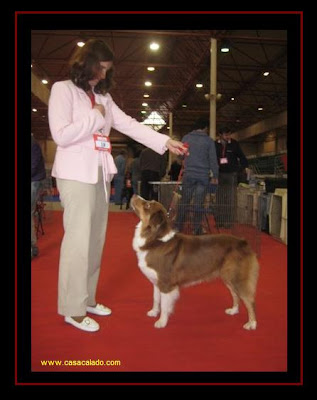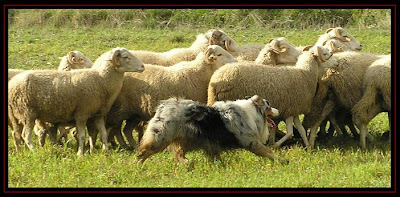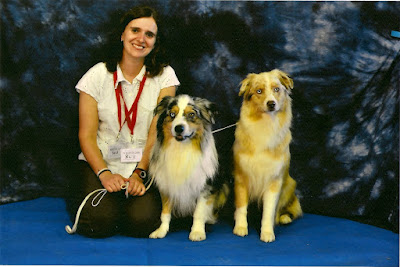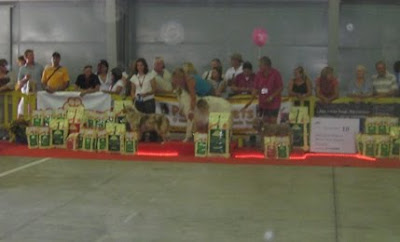
To view the card: http://www.sareunited.com/food24cards/viewCard.php?uid=1480720710389
Tuesday, December 22, 2009
Merry Christmas and Happy New Year 2009
Tuesday, December 01, 2009
International Dog Show of Santarém
A pleasent trip with good company of Portuguese Water Dog of Casa da Buba and a very nice dog show in Santarém.
Cookie, Australian Shepherd, achieved RCAC + RCACIB and Figo, Portuguese Water Dog , was 2º Junior.
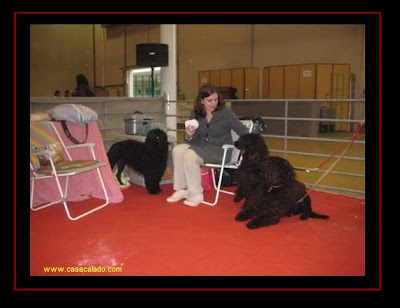
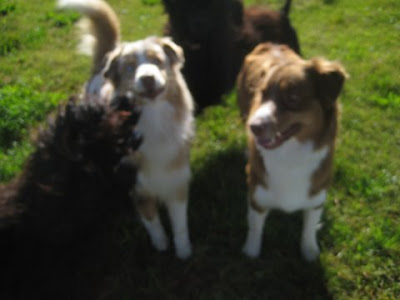

Other activities:
- Demos in VI Animal Show
- Herding with an Australian Shepherd SummerDogCamp 2010
- 115th and 116th Lisbon International Dog Show
- CNEMA 2010 - Portuguese Breeds and Agility !
- Spring Trophy – Agility Alenquer
- Belém - First Agility Experience
- Obedience Competition in Lagos 2009
- Scruffts 2009
- Lisbon International Dog Show 2009
- Portie and Aussies in Algarve Dog Show
-
- Obedience 100 Secrets
- Obedience Seminar
- Agility Workshop
- Cookie achieved Excellent in Obedience Class I
- Dog Show Int Vila Franca Xira 2009
- Workshop in Dog Behaviour on Educacão
- Dog Show Int Norte 2009
- Dog show Sousel 2008
- Teco acomplished Excelent in Obedience class I
- International Dog Show of Estoril
- Australian Shepherd in Herding Training Curse by Educacão
- Australian Shepherd and Golden Retriever in Sweet Fair at Lagos
- Lisbon and Mediterrânea dog show with our Aussies
- Angel and Teco, the two ambassador of our family
- Canine demonstration in Externato da Torraltinha
- Aussies and Golden in Dog Show at Elvas 2008
- Herding with our Australian Shepherd in Montemor-oNovo
- Australian Shepherd, Angel and Teco, on the 5º Journey
- In school with our Australian Shepherd
Monday, November 09, 2009
Australian Shepherd in Salema Beach
On this weekend the Lagos City Hall organized a guided tour to the Dinosaur footsteps traces left in Salena Beach 120 million years ago.
Definitely a very well done initiative since hardily I could distinguish this footsteps on the rock and since Prof. Luís Azevedo Rodrigues was the guide, everything was properly explained and become a very educational and lightening trip.
Because it was field visit I took Teco, my Australian Shepherd, to give him and people the chance to interact.
It was a very pleasant trip, in a sunny day, that allowed us to know a new Algarve area.






More info in:
- http://www.mnhn.ul.pt/dinos/public_html/Media/pagina%20interior.pdf
- http://issuu.com/ciencia_ao_natural/docs/national_geographic_portugal_2006
Other trips and travel:
- Dog trekking to a museum
- Dog trekking in Almada
- Dog Trekking in Serra de Sintra
- Alcochete - goldens and aussies
- Economic Trips with Dogs
- An Australian Shepherd in Armona Island
- Dogs in Meia Praia
- Silves, a visit to medieval times with Cookie, our Aussie
- Two Golden Retriever in Monchique
- A trip to the São Domingos Mine with our Australian Shepherd
- Taking a Golden Retriever to the fortress of Sagres
- A walk with my Australian Shepherd through Luz, Algarve Portugal
- A Walk with Brad, our Golden Retriever through Lagos
- Portugal Algarve, Amado Beach with our Golden Retriever and Australian Shepherd
Friday, October 16, 2009
Herding
Herding is one of the most antique activities engaged by the team men-dog. Its origin come from the necessity of men to have large herds and to control those herds. Being the dog his companion a collaboration relation form.
The first herding dogs were big animals, somewhat difficult to control, but help direction the herd.
When men necessities changed, many different type of dogs start to be mixed in a search of the ideal herding dog. Only the dogs in a litter that worked and show skills that were interesting to herding were kept and bread.
As centuries went by and modern age come, the shepherd dog lost some of its use, but still, many countries use herding dogs in farms and keep then with the some herding functions.
The herding trials were created to incentive people to continue this activity in our modern world. No individual that sees such a trial can’t keep be wonder with the team work between men and dog.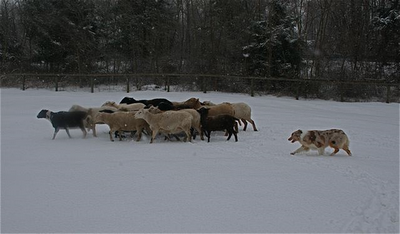
International Rules for Sheepdog Trials
INTRODUCTION
The object of a trial course is to test the ability of a dog to manage sheep properly under the variable circumstances which may be encountered in everyday work: the various tests such as Penning, Leading, Grazing, Traffic/Obstacles and Immobilizations (Stops) are all tasks which may be necessary as the shepherd goes his daily round. The aims of the sheepdog trials should be to promote good handling of the sheep with a minimum of stress for them as well a good handling of the sheepdog, to promote its utility and sport, and to secure and select the best working lines. It reflects "traditional herding".
Regarding the difficulties of finding the "ideal field" or the "ideal sheep" some flexibility is allowed in the distances and in the amount of sheep used in the three classes 1, 2, 3.
Before a dog is allowed to compete in a trial it has to pass the FCI Herding Working Test (Traditional style).
International trials shall be conducted according to these rules.
Those trials must be advertised as: CACIT International Herding Trial - FCI. The catalogue must show the FCI logo together with the following notice: “Fédération Cynologique Internationale (FCI)”.
GENERAL CONDITIONS
Organization
The organization is carried out by a national sheepdog working group which has to be affiliated to, or have an agreement with its National Canine Organization recognized by the FCI. Large areas with a variety of characteristics are required. The course is to be set up for a suitable work.
Trial Committee
The organizing committee for each local, national or international trial works under the responsibility of its national sheepdog working group which has to be affiliated to, or have an agreement with its National Canine Organization recognized by the FCI. .
This committee, with the agreement of its working group, will determine the number of entries for each class, the entry fees and all the awards.
Sheepdog trials should be organized on clean and closed field (natural edges, fences or flexi nets) that gives a maximum of security for the public, sheep and dogs.
The organizing committee consists of members in charge of :
- getting all the helpers they need,
- sending the programme to the competitors and judges as soon as possible,
- preparing the judging sheet (report) and providing assistants for the judges,
- laying out the course and supervising the running of their respective trial,
- controlling the good health of the sheep and the dogs,
- controlling the handler’s and dog’s qualifications to run in the class,
- keeping all the dogs out of the field before and after their respective run,
- handing over the judging sheet (report), correctly filled and signed, to each competitor.
It is the responsibility of each member organisation to select the team (handler & dog) for any local, national or international trial.
The organizing committee is to be headed by one course director responsible for all the tasks related to the trial; he should be present at all times.
Sheep
The sheep in all classes will be selected in such a way that each competitor shall work with sheep of equal quality. Preferably, the sheep used for the trials shall all come from the same flock and be similar in type. The sheep shall be well dogged, in good condition, age and shape. Lambs should be weaned.
The flock is to consist of minimum 15 sheep. Larger flocks (up to 80) should be preferred because they give a better opportunity for success. There should be enough sheep. The organizing committee should make sure to have sufficient sheep in order that each lot of sheep should not be stressed and should not be used more than twice in a day for class 3, three times for class 2 and maximum four times for class 1.
The sheep shall be brought to the pen (start) in the same way for each competitor in a quiet manner.
Dogs
The trials are reserved for sheepdogs of at least one year old and handled by a shepherd or herdsman. Monorchid, cryptorchid and sick dogs are not allowed to compete. Bitches in season must run last.
Sheepdog trials (traditional style) are open to herding dogs (FCI Groups 1, 2, 5) capable of performing such a course
excluding Border Collie and Kelpie
The dogs must be entered in a stud book recognized by the FCI. All results must be noted in the dog’s scorebook or any equivalent document. Identification of the dog: must be done by controlling their tattoo number or micro-chip.
Any dog which is not in condition e.g. a bitch which is near birth or lactating, a dog that is laming or suffering from an infectious disease shall not be brought to the ground.
Competitors whose bitch is in season must notify the organizing committee before the start and cannot take her to the ground until called to do so. No dog competing shall wear or carry anything that might in anyway assist or hinders its performance.
Competitors
Any owner or handler may work with several dogs in class 1, 2 or 3. Each competitor must be ready when called by the course director and anyone failing to answer the call can be disqualified and forfeit his run.
Competitors must be aware that even if the order of the programme will be followed strictly, the timing cannot be guaranteed if any handler is missing due to unforeseen circumstances.
Once a competitor has started, his work is under the evaluation and authority of the judges and he is considered to know the course and to follow it precisely. Before the trial starts, the course director has to summon all the competitors and brief them about all details related to the competition. All questions or clarifications have to be asked by the competitors at that time.
While working, competitors cannot get any help or advice from anybody. Any participant receiving assistance in any form will be disqualified.
Any participant in conflict with the rules or whose behaviour, in and out of the field, could harm, according to the organizing committee or to the judges, the organisation of the trial, will automatically be punished by sanctions or disciplinary actions such as :
a) disqualification from the day’s trial,
b) cancellation of any prizes and awards won by him at the day’s trial,
c) suspension from sheep dog trials in the organizing country for a period as decided by the organizing committee.
d) any other penalty considered suitable by the organizing committee.
Handlers without their dogs can inspect the course before the trial commences.
Participants shall keep their dogs under full control at all times. Any handler or/and his dog disturbing another dog or another participant who is working shall be eliminated and disqualified.
The affected participant will be given a re-run by the judge. It is within the authority of the judge to decide on a complete or a partial re-run. In case of a partial re-run, the points which the participant already achieved will count. Any participant who is disqualified shall lose all his points. Any participant losing one or more sheep shall be disqualified.
Entries are made in the name of the owner(s) but a dog can be handled either by the owner or by a handler who must be a member of an FCI recognized member or contract partner. When handlers are nominated, the owner(s) must indicate their name and address on the entry form.
Qualifications
In order to compete in the different classes, the following has to be achieved
(minimum qualifying points >= 70 %).
After 1 time >= 70 %, the dog can move to the next class.
After 3 times >= 70%, the dog has to move to the next class.
>= means “higher than or equal to”
Return to a lower class is not permitted.
All judging sheet handed over to the competitor have to be completed, signed by the judges and have to include the following information:
Excellent (Exc): >= 80 % up to the total points
Very good (VG): >= 70 % & < 80%
Good (G): >= 60 % & < 70 %
Non-qualifying: less than 60 %
>= means “higher than or equal to”
< means “lower than”
Complaint
Any decision made by a judge regarding the merits of the dogs, the placing and the points, is final and indisputable, unless the judge has violated formalities and existing rules.
Such complaints as well as complaints about how the trial was run, have to be made immediately in writing to the organising committee and against the deposit of 50 € as surety. If the complaint is found to be unjustified, this surety will be handed over to the organiser of the trial. If the protest is substantiated, the deposit will be refunded.
The judges will meet with the organizing committee and the protest shall, if possible, be settled. The majority decision will be final and binding.
Disqualification
In an unsporting situation, for the well-being of the sheep and the dog, the handler is asked to withdraw before being disqualified.
The handler will be immediately disqualified, if the dog is not under perfect control or grabs unnecessarily.
It is within the judge’s authority to decide if a gentle nip is needed in a particular situation. In case of a dog facing a nasty sheep that turns on to charge the dog several times, the judge might accept one self-defence grab if so justified and the competitor will be authorized to continue his course under the condition that the grab was not a nasty bite in which case the dog must be immediately disqualified.
A handler who is visibly drunk or under the influence of drugs will be disqualified.
In case the sheep are not workable, the judges, together with the course director, can take the decision to allow a re-run.
Re-run
The judges can instruct the course director to stop a dog at any point of its course and order a complete or a partial re-run if they consider that the circumstances justify such an action. This is entirely up to the judge to decide. In case of a partial re-run the points which the participant already achieved will count.
Judges
The organizing committee shall invite judges with experience and integrity and who are approved and recognized by their national canine organisation.
Exercises
A. Pen or sheepfold
B. Difficult passages
C. Conduct and manoeuvre
D. Stops
E. Intelligence of execution
A. Pen or sheepfold.
The judge evaluates, regarding the exit or re-entry of the pen, the relative difficulty of the two manoeuvres, on the proposed terrain, in order to attribute their relative value: exit, re-entry, protection of handler and jump.
Exit: After the authorization of the judge the handler may open the pen for the dog to enter. The handler may or may not accompany the dog, in order to accomplish the exit of the flock. The exit is accomplished by the active work of the dog under commands of the handler. It should be done calmly and the taking in hand of the flock should be immediate. The judge evaluates the behaviour of the dog in contact with the flock, its calmness and firmness.
Re-entry: should be accomplished by the active work of the dog under the commands of the handler. It should be calm and without jostling. Near the sheepfold the flock should be halted and held in place by the dog while the shepherd opens the gate.
Protection and jump : Before the exit of the flock from the enclosure where it is contained or at the time that it has re-entered the gate is closed, the handler simulates feeding and going around the paddock. The dog clears a passage between the shepherd and the flock. At the beginning or the end of the exercise in order to protect shepherd’s entrance or exit of the pen, the dog is placed between the flock and the gate. The handler leaves through the gate and leaves the dog protecting it. After the gate has been closed the handler recalls his dog which is to jump over a panel in order to return to his place at the feet of the handler.
B. Difficult passages.
There should be at least two difficult passages, even three, as natural as possible. For example: narrow passage, or between crops, hedges, or barriers between two fields, or passage of a bridge, or sorting pen.
The jury should distribute the points in this test according to the relative difficulty of the exercises and their number and in appreciation of the approach, the placement of the handler, the dog, as well as the control and taking in hand of the flock at the exit. The entry of the flock into difficult passages should be done by the dog and executed calmly. In the case of a bridge the handler and dog both should cross it to continue the course because, even if it is artificial, it represents a gorge too large or too deep to cross. In the case of a sorting pen, the dog may enter but not the handler. In other cases the handler places himself in the fashion that appears to be the best way of negotiating the passage. Going around or past an obstacle brings about the loss of points for that obstacle and the handler is not allowed to try again.
C. Conduct and manoeuvre.
Graze. The work consists of the graze, either square or elongated in a natural field or temporary field with its limits marked by four stakes at the corners or along the front of an authorized space (15 x 15 meters).
The jury evaluates the shepherd’s handling, the position of the dog in relation to the flock and the ability of the dog to bring the flock into the graze and maintain it in place with calmness, efficiency and initiative (time is up to the judge's decision).
Holding the flock and catching a sheep.
While the flock is immobilized and calm in the indicated space, the handler catches and briefly holds a marked sheep indicated by the jury. During this time the dog should contain the rest of the flock in the indicated space, if possible on its own initiative.
Work at distance (150 to 300 meters). After having regrouped and stabilized the sheep within the indicated limits, the handler:
- can entrust the dog to assure on its own initiative the maintenance of the flock in the space previously defined in order to earn maximum points for this exercise and go to the place designated by the jury. If the flock goes outside the limits or if the handler must command the dog to ensure that the flock stays in place, points are deducted.
- Or, accompanied by the dog, go to the place indicated by the jury. At the authorization of the jury the handler, without changing place, commands the dog to re-gather the group and calmly bring them to him along the indicated path to him.
Car passage: This may be done on a real road or on a simulated road that represents the conditions encountered on a real road. The road must be clearly delineated, with at least one side which the flock may "lean on" during the passage. In the case of a real road, where the traffic cannot be interrupted, but only controlled, the average of the different passages will be kept for our definition.
Movement: The jury appreciates the movement of the flock during all the duration of the course. The dog will be noted for his ability to guide the flock between two exercises or obstacles, following the defined course in accordance with the relative difficulty of the movements and their number.
D. Stops.
The dog should be capable of stopping the flock in all circumstances and there should be at least two stops, placed at a natural place: path, road, enclosure, crop, etc. The jury distributes the points of this test in accordance with the relative difficulty of the stops.
The stopping of the flock is a very important manoeuvre and should be done, not by the handler, but by the dog which must come to the front of the flock. After the flock stops and the handler checks to see that the passage is not dangerous, the resumption of movement should be fairly quick, without jostling, with the dog going around the flock to push at the rear or at least assure the control of a side.
Going past the stop brings about the loss of all the points for this exercise and the handler is not authorized to take up the flock in order to attempt a new stop.
E. Intelligence of execution
This is judged throughout the whole trial and divided into three headings:
a. Commands: This may be made by voice, gesture or whistle and will have a great influence on the behaviour of the dog and the quality of its response.
The jury evaluates the vocabulary, clarity, force, intonation and number of commands. Useless commands or commands not followed by the dog are penalized and it should be recalled that each sound of the whistle is a command whatever the mode, the commands which are applied to each movement should always be the same and as abstemious as possible.
b. Obedience: this should be immediate, complete and definitive: it conditions the good control of the flock.
c. Activity - initiative - gentleness – behaviour : the jury evaluates the ability of the dog to gather, guide, stop or move the flock, as the handler demands, as well as the ability of the dog to intervene on its own initiative and advisedly channel, stop or hold the flock in place and regroup strays.
The behaviour of the dog to strange persons is to note: it must be natural, lively, not shy or aggressive. A little reserve is accepted.
Save in exceptional cases the dog should not bite the sheep and all brutality is severely penalized. A brief nip is admissible, only when necessary and in order to keep control of the flock. Flagrant and untimely bites are the cause of immediate disqualification and the dog should not endanger the sheep.
Summary: Class 3 (Time 35 minutes)
1) Pen or sheepfold 25 p
2) Difficult passages 25 p
Min. 105 points 3) Conduct/Manoeuvre 50 p
4) Stops 20 p
5) Intelligence of execution 30 p
150 p
Class 2 (Time about 30 minutes)
1) Pen or sheepfold 25 p
2) Difficult passages 15 p
Min. 70 points 3) Conduct/Manoeuvre 20 p
4) Stops 10 p
5) Intelligence of execution 30 p
100 p
Class 1 (Time about 25 minutes)
1) Pen or sheepfold 25 p
2) Difficult passages -no-
Min. 52,5 points 3) Conduct/Manoeuvre 20 p
4) Stops -no-
5) Intelligence of execution 30 p
75 p
Point deductions:
1. Pen or sheepfold
• anticipates departure
• too hurried or too slow in work allows re-entry
• allows runaway of more than 30 meters, does not work, does not control sheep
• does not keep the sheep back from handler when both are inside pen, does not jump
• allows runaway of more than 50 meters
2. Difficult passages
• sheep step out of limits, poor approach
• dog poorly placed
• late in negotiating passage, bad negotiation of passage, intervention of handler
• loss of control when exiting passage
• flock goes around or does not pass through
3. Conduct and manoeuvre
• By commanding at a distance (graze) dog poorly placed
• goes through the course too rapidly/too slowly
• late in putting the flock in place
• difficulty in immobilizing the flock
• tentativeness in catching/holding the marked sheep
• choppy, winding, imprecise transit of the course scattering or jostling the sheep
• grazing out of limits
• dog poorly placed (car passage)
• loss of control, little work
• does not immobilize sheep
• movement of flock during "hold" and "stops"
• dog returns to handler during graze
• complete escape of flock
4. Stops
• a sheep that pushes past
• sheep pulled back too far, slight overflow from the flock, but controlled
• late in resuming motion
• stop done by the handler, not the dog
• dog keeps working, does not stop
• allowing total movement
5. Intelligence of execution
a) commands
• useless or not performed
• too numerous, lacking in firmness
• wrong command
• recalling the dog on its abandoning work
• correcting the dog
b) obedience
• does not obey command
• late in obeying
• obeys command in a wrong way
• abandons the flock / disqualification
c) activity – initiative - gentleness
• wandering, chasing
• difficulty in asserting itself, fearfulness
• cutting into the flock, scattering the flock
• lack of interest in work, inattentive
• dog places itself poorly, allows escapes
• doesn't move when ordered
• brutality, rough gripping
• unnecessary grip
6. Disqualifications
• wrong act by the handler
• drunken and/or under the effect of drugs
• unjustified dispute
• hindrance of the normal unrolling of the course
• abandoning the flock
• refusal to obey, flagrant disobedience
• unjustified or dangerous bites
• repeated brutalities by the dog or handler
• frequent scattering of the flock
• fearfulness or aggressiveness
• failure to control the flock
• dog wandering during the passage of another competitor
Source: www.fci.be/uploaded_files/International%20Rules%20for%20Sheepdog%20Trials_Traditional%20Style_EN.doc
Other dog sports:
Friday, October 09, 2009
Tuesday, October 06, 2009
Sunday, September 27, 2009
Golden Retriever Dog Party
This Saturday Bri and Louys, Golden Retriever, puppies made 1 year and we organized a dog party. A sucess and lot of fun for friends and dog lovers.
Thanks for coming !!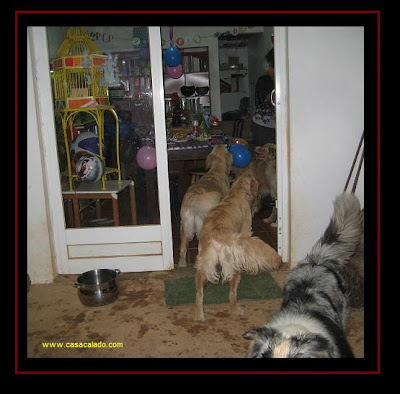


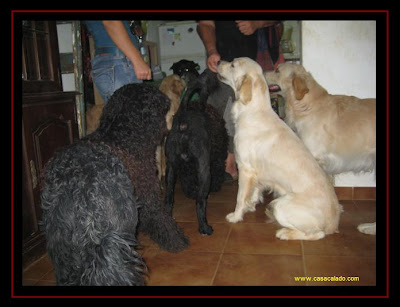








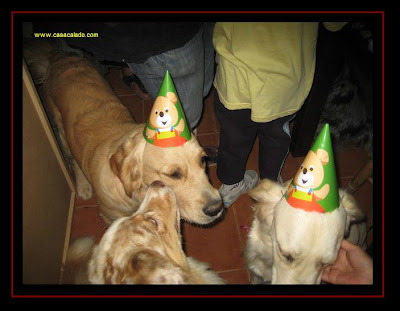


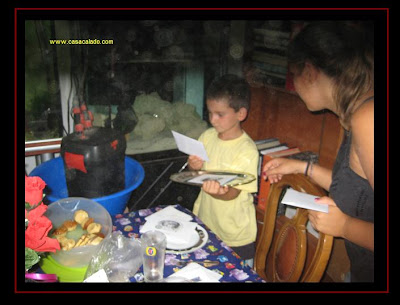





Tuesday, September 22, 2009
Scruffts 2009


Congratulations to the organization of the event, that matches the official ones and I hope the raised money will be enough to help the animal associations.
Other activities:
- Herding with an Australian Shepherd SummerDogCamp 2010
- 115th and 116th Lisbon International Dog Show
- CNEMA 2010 - Portuguese Breeds and Agility !
- Spring Trophy – Agility Alenquer
- Belém - First Agility Experience
- Obedience Competition in Lagos 2009
- International Dog Show of Santarém 2009
- Lisbon International Dog Show 2009
- Portie and Aussies in Algarve Dog Show
-
- Obedience 100 Secrets
- Obedience Seminar
- Agility Workshop
- Cookie achieved Excellent in Obedience Class I
- Dog Show Int Vila Franca Xira 2009
- Workshop in Dog Behaviour on Educacão
- Dog Show Int Norte 2009
- Dog show Sousel 2008
- Teco acomplished Excelent in Obedience class I
- International Dog Show of Estoril
- Australian Shepherd in Herding Training Curse by Educacão
- Australian Shepherd and Golden Retriever in Sweet Fair at Lagos
- Lisbon and Mediterrânea dog show with our Aussies
- Angel and Teco, the two ambassador of our family
- Canine demonstration in Externato da Torraltinha
- Aussies and Golden in Dog Show at Elvas 2008
- Herding with our Australian Shepherd in Montemor-oNovo
- Australian Shepherd, Angel and Teco, on the 5º Journey
- In school with our Australian Shepherd
Friday, September 18, 2009
Scruffts 2009
The 10th Scruffts Dog Show taking place at FATACIL in Lagoa, Algarve on Sunday the 20th September 2009, is sponsored this year by Albuferia based pet food and supplies company “Paws4Pets.”
“We are delighted,” says Julie Pickering Sales Director of Paws4Pets,
“to be the main sponsor of this years show and we will supply the prizes for all judging classes and the agility winners.”
The judge for 2009 will be the Vice President of the Portuguese Kennel Club Snr Pedro Albergaria. In addition to the normal judging classes there will be demonstrations by the AHCTA Search and Rescue Team from Faro and also obedience displays. Local company “Dogsbodies” have also announced that they will offer as a raffle prize a commissioned hand painted pet portrait. The painting will be done by local artist and “Dogsbodies” partner Karyn Real and be presented after completion by APAA President Alan Camplin-Smith to the winner of the raffle.
Another feature of the show will be personalised seminars by international dog trainer, Yolande Bosman with particular regard to clicker training for puppies and older dogs.
For those bringing their dogs to the show are reminded that Portuguese Ministry of Agriculture permission is that all dogs attending Scruffts must be micro chipped and have their vaccinations papers.
Entrance to the show is 1 euro with children free, whilst class entry fees are 3 euros per class per dog.
For more information please e.mail
scruffts2009@yahoo.co.uk
The 10th Scruffts Dog Show taking place on Sunday 20th September at the FATACIL Pavilion in Lagoa, will welcome for the first time the Association for Guide Dogs for the Blind (Associação e Escola Cães Guia da Mortagua) who have only been established here in Portugal for a few years. The show will give the guide dogs and their handlers an opportunity to mingle and interact with those visiting the show and increase public awareness of what here in Portugal is a fairly recent but worthy cause.
In addition to the guide dogs, Faro based AHCTA Search and Rescue Team will show a number of simulated “emergency response” demonstrations. Besides the 17 pedigree and non pedigree judging classes there will another opportunity for dogs and their owners to try the Agility Course organised by Margaret Gobby and also learn about “Clicker” training with Yolande Bosman.
Says APAA President Alan Camplin-Smith “We are delighted that Paws4Pets - the well known Albufeira based pet food and supplies company - has agreed to be our main sponsor; they are providing all the prizes for the 19 judging classes. There has been an excellent response from individuals and businesses such that all individual judging classes have now been sponsored, as well as there being over 25 trade stands booked for the event. With lots of entertainment planned, and plenty of food outlets, this is a day out for all the family.”
Further clarification has now been obtained from the Ministry of Agriculture on those bringing their dogs to the show. All dogs entering any of the judging classes need up-to-date vaccination papers (and these must be available for inspection by the Vets at the Show); additionally, dogs born after 1st January 2008 - and all dangerous breeds - must have microchips.
Tuesday, September 15, 2009
Tuesday, September 08, 2009
Economic trips with dogs
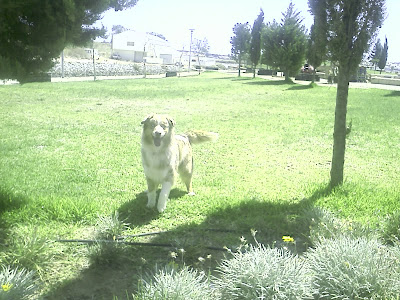



Other trips and travel:
- Dog trekking to a museum
- Dog trekking in Almada
- Dog Trekking in Serra de Sintra
- Alcochete - goldens and aussies
- An Australian Shepherd in Salema Beach
- An Australian Shepherd in Armona Island
- Dogs in Meia Praia
- Silves, a visit to medieval times with Cookie, our Aussie
- Two Golden Retriever in Monchique
- A trip to the São Domingos Mine with our Australian Shepherd
- Taking a Golden Retriever to the fortress of Sagres
- A walk with my Australian Shepherd through Luz, Algarve Portugal
- A Walk with Brad, our Golden Retriever through Lagos
- Portugal Algarve, Amado Beach with our Golden Retriever and Australian Shepherd

